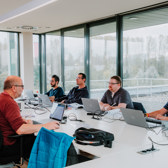Building your own Models with Azure Machine Learning
UADS
3 days
Interested in a private company training? Request it here.
Not ready to book yet? Request an offer here.
Machine Learning Introduction
Before ML can be applied, the key concepts of machine learning need to be discussed.
- Supervised versus Unsupervised Machine Learning
- Why use Machine Learning?
- Splitting data in training, test and validation sets
Applying a machine learning methodology
When applying machine learning in an enterprise context, it's important to have a methodology to plan, document and execute the different steps in the machine learning proces.
- The 6 steps of the CRISP-DM Machine Learning Methodology
- Data Preparation
- Classification, Regression and Clustering
- Measure Model Quality
- Cross-validation and Hyper-Parameters
- Machine Learning in the Microsoft AI Stack
Setup your Machine Learning environment
Before you can start developing machine learning solutions, you must first create an environment in which you can store and run your Python code. Both local and cloud solutions are presented.
- Configuring your Environment
- Working with Python in Notebooks
- Using Environments and Notebooks in Microsoft Fabric
Prepare your data for Machine Learning
Like all data used for business intelligence, also data for machine learning should be cleansed. But machine learning data has some special requirements. This module shows how to use Python to prepare your data for machine learning.
- Exploring the scikit-learn package
- Estimators and Transformers
- One-Hot encoding for categorical data
- LabelEncoder and OrdinalEncoder
- Dealing with missing values
- Handling outliers
- Standardization and Normalization for continuous values
- Preparing free text fields
- LAB: Preparing data for Machine Learning
Build your own Machine Learning Model with scikit-learn
Many business problems can be tackled by basic machine learning techniques. In this module the most common machine learning approaches such as linear regression and random forests are used with Python. We also pay attention to model inspection.
- Classification
- Decision Trees, Logistic Regression and Support Vector Machines
- Model tuning: Working with Hyper-Parameters
- Regression Models
- Linear Regression and Neural networks
- Unsupervised learning: Clustering
- LAB: Classification and Regression with scikit-learn
Azure Machine Learning
Machine learning on a local machine and a small dataset is one thing, running this on larger datasets or more CPU-hungry techniques (or even GPUs) can become a challenge. Another problem is deploying your model: How can we easily call the resulting model from within other applications? Azure Machine Learning helps answering these questions.
- Azure Machine Learning overview
- Create an Azure Machine Learning Workspace
- Setting up Compute and Datastores
- Creating and Querying Jobs and Experiments
- Deploying and Using Models
- Creating and Registering Images
- Deploy Images as Web Services
- LAB: Building ML Models in Azure Machine Learning
Automated Machine Learning
Part of the machine learning process can be automated. Azure Automated machine learning provides a web portal and a Python API to automate data preprocessing and model training.
- Building and Deploying Automated ML models
- Calling Automated ML from Python
- LAB: Working with Automated ML
Microsoft Fabric Data Science
The Data Science experience in Microsoft Fabric provides notebooks, so all the previous Python code could be run in their. But Microsoft Fabric provides extra functionality as well: From pre-installed machine learning frameworks (SparkML, FLAML) to model management (MLFlow).
- Scale out your machine learning with SparkML
- Log your machine learning with MLFlow in Experiments
- Microsoft Fabric Model Management
- FLAML: Automated machine learning in Microsoft Fabric
- LAB: Train your machine learning model in Microsoft Fabric
Getting started with Keras for Deep Learning
From all the machine learning techniques there is one that gets popular for more challenging problems: Multiple layers of neural networks, better known as deep learning. For problems such as image recognition, speech understanding etc. this is currently the way to go. But it's from a mathematical point of view a very challenging technique. In this module the basics of deep learning are introduced.
- From Neural networks to Deep learning
- Overview of Deep Learning Frameworks
- Getting started with the Keras Framework
In many AI solutions pre-trained models (such as ChatGPT) are used. But in some cases, custom models trained on your corporate data is essential to make predictions within your business processes. This training focusses on the latter. First you will learn how to train models locally using Python. This code is then used in Azure Machine Learning, which provides extra features, such as scale out training, easy deployment and monitoring.
This training aims at people with basic Python knowledge who want to start or further grow in a data science role. No machine learning knowledge is needed, but basic Python data manipulation skills are required to take the labs. If needed, attend our Python for data engineering training first.







